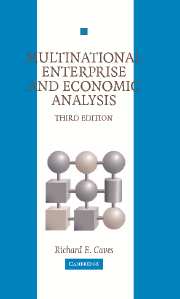Book contents
- Frontmatter
- Contents
- Preface
- 1 The Multinational Enterprise as an Economic Organization
- 2 The MNE and Models of International Economic Activity
- 3 Organization and Growth of the MNE
- 4 Patterns of Market Competition
- 5 Income Distribution and Labor Relations
- 6 Investment Behavior and Financial Flows
- 7 Technology and Productivity
- 8 Taxation, MNEs' Behavior, and Economic Welfare
- 9 Multinationals in Developing Countries and Economies in Transition
- 10 Public Policy
- Bibliography
- Name Index
- Subject Index
- References
Bibliography
Published online by Cambridge University Press: 18 December 2009
- Frontmatter
- Contents
- Preface
- 1 The Multinational Enterprise as an Economic Organization
- 2 The MNE and Models of International Economic Activity
- 3 Organization and Growth of the MNE
- 4 Patterns of Market Competition
- 5 Income Distribution and Labor Relations
- 6 Investment Behavior and Financial Flows
- 7 Technology and Productivity
- 8 Taxation, MNEs' Behavior, and Economic Welfare
- 9 Multinationals in Developing Countries and Economies in Transition
- 10 Public Policy
- Bibliography
- Name Index
- Subject Index
- References
- Type
- Chapter
- Information
- Multinational Enterprise and Economic Analysis , pp. 311 - 374Publisher: Cambridge University PressPrint publication year: 2007



